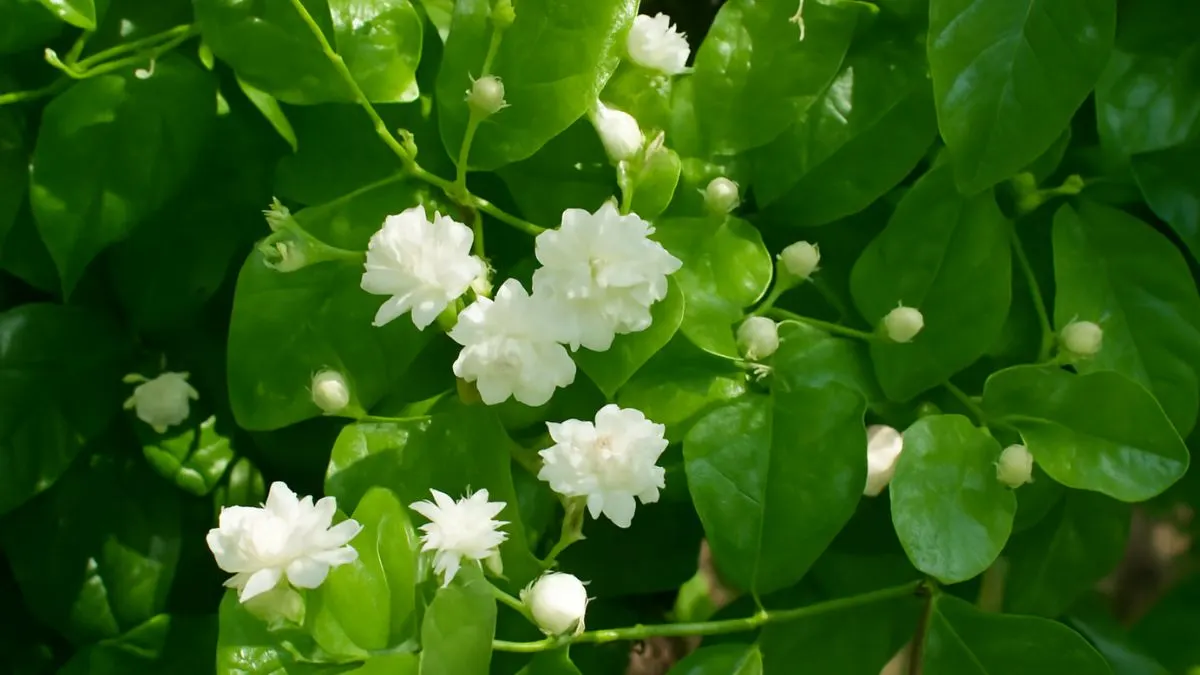Few plants capture hearts as much as the Arabian Jasmine plant. Known for its intoxicating fragrance and pure white blooms, it has been a cherished garden plant for centuries. From wedding garlands in Asia to sacred offerings and perfumes, its uses span across traditions, cultures, and continents.
The good news? You don’t need to live in a tropical paradise to enjoy it. With the right care, Arabian Jasmine thrives in warm, tropical to subtropical climates and adapts beautifully to pots, containers, and even hanging baskets. Let’s explore everything you need to know to grow, nurture, and enjoy this evergreen beauty in your own home.
Botanical Overview of Arabian Jasmine

- Scientific Name: Jasminum sambac
- Common Names: Arabian Jasmine, Mogra, Sampaguita
- Growth Habit: Grows as a small bush or creeper up to 10 feet (3m) tall
- Native Region: South and Southeast Asia
- Climate: Arabian Jasmine thrives in warm, tropical to subtropical climates
With glossy green leaves and intensely fragrant flowers that bloom year-round in the right climate, Arabian Jasmine is both ornamental and symbolic.
Also Read: Evergreen Flowering Vines That Will Transform Your Garden Walls
Ideal Growing Conditions
1. Sunlight & Temperature
- Sambac Jasmines will grow under full sun conditions, but they also do well in partial shade.
- Jasmine Sambac thrives in bright indirect light to full sun, making it versatile for both gardens and balconies.
- The best growth happens in warm temperatures between 70–85°F, though it can tolerate slight variations.
2. Soil Requirements
- Always grow Arabian Jasmine in well-draining soil under full sun to partial shade.
- Use soil enriched with compost or organic matter for maximum bloom.
- For potted plants, add sand or perlite to improve drainage.
3. Watering Needs
- Watering: Moderate watering is good for Mogra plant.
- Keep soil consistently moist, but never waterlogged.
- In winter, reduce watering frequency to prevent root rot.
Also Read: Grow These 7 Edible Plants in Just Water—No Soil, No Mess!
Growing Arabian Jasmine in Pots & Hanging Baskets
Not everyone has the luxury of large gardens, but Arabian Jasmine adapts easily:
- Jasmine can grow in a pot or hanging basket just as well as in open ground.
- Use clay or ceramic pots for better aeration.
- Prune regularly to control shape and encourage flowering.
This makes it perfect for urban homes, balconies, patios, and even indoor spaces with good sunlight.
How to Plant Arabian Jasmine
- Seed or Cutting Propagation
- Leafy cuttings from a healthy plant root quickly.
- Seeds take longer but are equally effective.
- Planting Depth
- Place cuttings 2–3 inches deep in moist, well-draining soil.
- Keep them under indirect sunlight until new growth emerges.
- Fertilizing
- Use a balanced fertilizer every 3–4 weeks during the growing season.
- A phosphorus-rich fertilizer boosts flowering.
Also Read: How To Help Your Yucca Plant Flower
Seasonal Care Guide
Season |
Care Routine |
Spring |
Heavy flowering season; feed with fertilizer and water regularly |
Summer |
Maintain 70–85°F temperatures, provide shade in extreme heat |
Autumn |
Continue pruning and moderate watering |
Winter |
Reduce watering, protect from frost if in cooler climates |
Uses of Arabian Jasmine
- Fragrance – Its essential oils are used in perfumes and incense.
- Cultural Symbolism – In the Philippines, Sampaguita is the national flower. In India, garlands of Mogra flowers are used in weddings and festivals.
- Medicinal – Traditional practices use it for stress relief and skin care.
- Ornamental – A perfect plant for pots, hanging baskets, or small gardens, giving both greenery and fragrance.
Common Problems & Solutions
- Yellowing Leaves: Often due to overwatering. Fix by adjusting watering schedule.
- No Blooms: Lack of sunlight or poor soil nutrition. Move plant to a sunnier spot and add fertilizer.
- Pests: Watch for aphids and mealybugs. Treat with neem oil sprays.
Also Read: Alliums: The Fireworks of the Flower World
Personal Experience
When I first planted Arabian Jasmine in a pot, I was unsure if it would survive our dry summers. By following the simple rule of moderate watering and ensuring bright indirect light, it not only survived but bloomed beautifully. The fragrance filled the evenings, and I even used the flowers in homemade essential oils. It quickly became the centerpiece of my balcony garden, proving that Arabian Jasmine thrives in warm, tropical to subtropical climates but can adapt if given proper care.
Why Arabian Jasmine Belongs in Your Garden
- Low-maintenance yet rewarding.
- Grows well in pots, hanging baskets, and gardens.
- Adds fragrance, beauty, and cultural richness.
- Adaptable to both tropical countries and controlled environments in cooler regions like Canada and the USA.
The Arabian Jasmine plant is more than just a decorative flower. It is a plant of heritage, fragrance, and resilience. Whether you want a small bush or a cascading creeper up to 10 feet tall, Jasmine Sambac will never disappoint. From patios in Canada to tropical backyards in Asia, this plant unites gardeners worldwide.
👉 Ready to grow your own Arabian Jasmine? Start with a pot, give it warmth and love, and soon your garden will smell like heaven.






